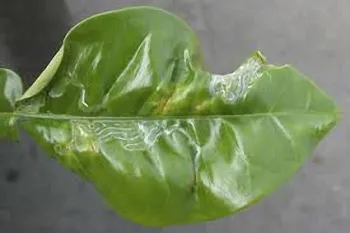Leaf miners

Leaf miners are just one of the many pests that affect our gardens. The two leaf miner types most often found in Marin are the Liriomyza spp, a mostly black & yellow fly with clear wings, and Phytomyza, a blackish gray fly on top with a cream- colored abdomen. Females of both these genera insert tiny eggs into the leaves of numerous vegetables and ornamentals so that their larvae, when they hatch, can feed within the leaf tissue. The larvae use their mouthparts to rupture plant cells, weaving long serpentine trails called mines through the leaf. Adult female flies also damage plants by piercing into leaves with their ovipositor and sucking the sap.

Identifying signs that the pest you are dealing with is a leaf miner are the presence of larval mines and, when populations are high, stippling due to females puncturing the leaves to feed and lay eggs. These mines appear as white, gray, or paler in color wavy lines, tunnels, trails, or blotches just under the surface of leaves and soft stems. In most cases, however, leaf miners cause little damage, and control is not necessary. Injuries are mainly cosmetic, so treatment decisions are based on the plant's appearance.
Flies emerge in spring, usually in late April or early May. The females lay their eggs typically around midday. Larvae are active for about two to three weeks. They drop to the ground next to plants to transform into pupae, surviving over the winter as pupae. Many generations can occur each year as the entire life cycle can be completed in three weeks when the weather is warm.
Leaf miners are most often found on seedlings or transplants. Inspect new plants and seedlings for signs of leaf mines before planting. And then, only plant in areas of your garden where you have not had an infestation. If you have had an infestation of leaf miners, prune and destroy any affected leaves on infected plants. Remove old plants at the end of the growing season.
Avoid pesticide use, as it suppresses parasitoid activity. Almost always, outbreaks are associated with pesticide use, as insecticide applications differentially destroy natural enemies. If the number of leaf mines increases, Spinosad can be an effective option if applied to leaves at times that coincide with periods when egg laying occurs, usually shortly after leaves have expanded in spring.
Notably, leaf miners are resistant to many insecticides and difficult to spray directly. It is advisable to keep your garden area free of weeds such as chickweed, lamb's quarters, nightshade, and plantain, as this reduces their availability as a leaf miner food source. Even though the mines that leaf miners leave on plants make them easy to identify as the culprit, it is critical that gardeners remember to correctly identify the insect causing the damage before applying any insecticide.
Leaf miners have many natural enemies in California, including parasitic wasps, predatory bugs, spiders, earwigs, and ants. Two of their natural enemies, parasitic wasps and hummingbirds, are particularly good at reducing the population of leaf miners. Other parasites attack leaf miners, but their feeding habits protect them from most predators. Beneficial nematodes attack the pupae of leaf miners in the soil. Birds and insects feed on them.
Plant plants that attract natural enemies or predators of leaf miners, e.g., insectary plants, which increase the abundance and effectiveness of natural enemies that help suppress pest populations. Insectary plants, e.g., fennel, buckwheat, and marigolds, can host alternate prey that will feed the natural enemies and keep them abundant locally. Avoid the use of pyrethroids to disrupt leaf miner biological control.
Liriomyza spp., commonly known as the American serpentine leaf miner, has a wide range of host plants. The measures cited above are a good place to start to prevent or address evidence of leaf miner activity in your garden.
By Martha Proctor, June 14, 2025
